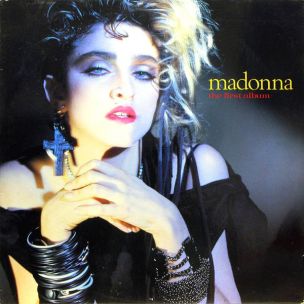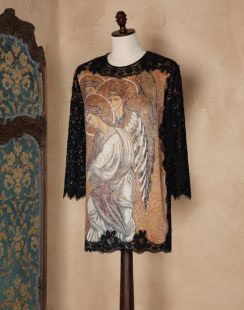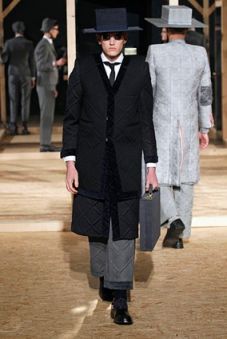Faith in fashion

In the world of fashion, the major faiths have inspired trends for years. From clothing to jewellery and now accessorises, religious symbolism is everywhere.
As a fashion geek myself, I've noticed that over the years Christian and Islamic faiths in particular are frequently popping up in fashion trends. Looking at the most popular trends of 2013, both on the streets and on the catwalk, this is more evident than ever.
In the 1980s religious symbols were already popular on jewellery garments. Queen of pop, Madonna, wore cross shaped necklaces and earrings at the prime of her career for example.
Since then crucifixes have appeared on countless necklaces, earrings, rings and so on. New York jeweller, Pamela Love, has taken the trend further with daggers replacing the crucifix on a necklace inspired by rosaries.
Recent times have seen Christian symbolism stem from jewellery to clothing. Like most teens, I have a number of items in my wardrobe that have a cross printed somewhere, with Topshop and Asos among others stores, stocking an abundance of cross inspired pieces.
Who would have thought that two straight lines would be so appealing to the world?
It surprises me that people of no faith even have tattoos showing the crucifix. It is impossible to conclude how many Christians are offended by this as every disciple is different. Personally I rejoice over this crucifix trend as the visibility of the cross is a good thing, but I understand why traditionalists may be disheartened when the cross is worn for non-religious purposes. Perhaps age plays a factor here, or more traditional perspectives.
I see the cross's popularity as a good thing- such trends are presenting Christianity in new and beautiful ways. Who knows, this may be something God planned, as a way of showing Christ to the younger generation.

Dolce and Gabbana is one fashion house that has been using Catholic references for years, such as saint-inspired clothing and golden jewellery. In the past they used rosary beads, like those associated with Catholic prayer, as necklaces.
The fashion duo enjoy exploring their south Italian heritage, hence the explicit references to Catholicism shown in their work. For their 2013 Fall collection, saints, angels and kings are printed onto t-shirts, dresses and skirts alike.
In recent years they have found inspiration in old churches. Traditional churches and stain-glass windows are undeniably beautiful to the religious and non-religious alike, so it is understandable that designers are still finding inspiration in such visually engaging architecture.
Dolce and Gabbana's recent collection oozes beauty and sophistication, bred from the golden colour palette - a colour associated with monarchy and the medieval church.
Menswear has equally been inspired by religion. Designer Thom Browne's AW13 collection was a tribute to the clothing of Orthodox Jews. With long dark coats and iconic hats, Browne certainly established the Orthodox Jewish look.
In the 1990s designer Jean Paul Gaultier was also inspired by Orthodox Jewish apparel. After much scrutiny for his 'Chic Rabbis' collection, Gaultier defended his work saying: "I saw a group of rabbis leaving the New York Public Library on Fifth Avenue. I found them very beautiful, very elegant, with their hats and their huge coats flapping in the wind. It was a fantastic scene."
Gaultier found similar inspiration from Virgin Mary in his 2007 collection. On the 2007 catwalk, his dresses were styled as stain-glass windows and models wore extravagant yellow halos. One cut-out dress had an image resembling baby Jesus printed onto its body.

Religion also became inspiration for the Ksenia Schnaider Spring/Summer 2012 collection. Designers from Eastern Europe, where religion has a powerful influence in society, made explicit references to religion in last year's collection, particularly the clothing of monks.
The collection is mainly unisex and utilitarian. Black and white colouring dominates the collection beside a few additional, subtle colours.
Similar to the frequently appearing crucifix, Ksenia Schnaider's collection resonates with the imagery of the Christian faith.
Other designers take inspiration from alternative religions such as the Islamic faith. Burqas have adopted a new meaning in modern days, recently being used as a fashion accessory on the catwalk.
Muslim women traditionally wear burqas as a symbol of modesty and faith. The full lengthened embroidered dress - the Abaya - is equally as popular for Islamic women, perhaps a clothing piece that will soon hit catwalks.
Muslim girls are progressively wearing brightly coloured hijabs and head scarves when compared to the traditional black garments worn by most. To such, these head scarves offer an expression of personality.
American singer and fashion icon, Lady Gaga, has recently been photographed wearing burqa-like garments, turning these cultural pieces into an avant-garde fashion trend.
Gaga is known for modelling daring ensembles, though I wonder how Muslim women feel about this.
Interestingly, the pop star has recently released a track called "Burqa" which is causing controversy amongst Muslim women for its sexual lyrics and inappropriate connotations.
Gaga sings: "Do you wanna see me naked, lover? Do you wanna peak underneath the cover?"
Hind Makki, a blogger for Patheos, spoke on 'HuffPost Live's Dena Takruri', saying that Lady Gaga is taking the significance out of burqas and out of the Islamic culture. She said: "There is a thin line between artistry and appropriation and between appropriation and solidarity."
Some designers may use faith for its symbolism but most use it for its aesthetic reasons. Jean Paul Gaultier found Orthodox Jews beautiful and elegant, something that could be taken as a compliment.
Others, like Lady Gaga, seem to forget the holy significance of religious garments.
Fashion brand, BOY London, who have stock sold at Selfridges and Asos, are even using the Nazi Party eagle as a fashion symbol. Is this a case where designers have gone too far?
To most, the idea of having a symbol associated with Adolf Hitler become a form of fashion is completely disrespectful to the Jewish community. Yet consumers continue to buy such clothing with no consideration as to what it means.
Perhaps this is a sign of modern times where consumers no longer care about religious controversy when it comes to fashion. It seems that people care less for religion and more about their image.
Acclaimed brand, Prada, is not one to be afraid of controversy and this season they are taking inspiration from turbans.
It seems fashion designers just cannot get enough of faith in their creations. Who can really blame them? Holy symbols and religious clothing are beautiful and it's wonderful that this is, on the whole, appreciated and even respected by an industry often associated with hollow vanity.











